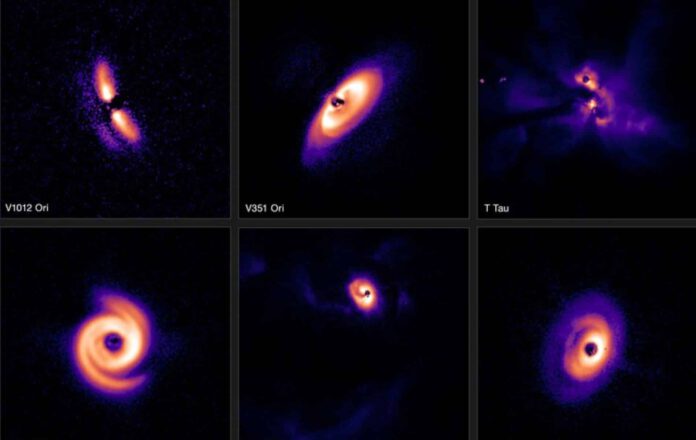
A New Phase in the Study of Planetary Genesis
Astronomers say recent research points to a “shift” within the field of study that grapples with the still somewhat mysterious formation of planets.
In three studies published in Astronomy & Astrophysics, scientists present one of the largest ever inventories of planet-forming disks. The studies include observations of more than eighty young stars surrounded by disks of gas and dust from which planets may emerge. “This is truly a shift within our field of study,” concludes researcher Christian Ginski. “We have gone from the in-depth study of individual star systems to this vast overview of entire star-forming regions.”
The Beginning
Scientists have by now discovered more than 5000 exoplanets. Exoplanets orbit a star other than our sun, often in systems different from our own solar system. The diversity amongst these systems provokes questions. To understand and explain this diversity, astronomers must observe the dust and gas-rich disks surrounding young stars; these disks serve as the nurseries of planet formation.
Dozens of Young Stars
In the past, researchers have looked at these nurseries – each time focusing on one gas and dust disk. The new studies published in Astronomy & Astrophysics took a different approach and studied dozens of young stars, all enveloped by a gas and dust disk. The observations were made with the Very Large Telescope in Chile.
Taurus, Chameleon I, and Orion
Using this telescope, they inspected three star-forming regions all located within the Milky Way: Taurus, Chameleon I (both found around 600 light-years away from Earth), and Orion (approximately 1600 light-years away). In these regions, new stars are being born. The scientists based their research on 86 of such young stars, all surrounded by disks of gas and dust from which planets are or will be formed.
Early Stage Diversity
The observations reveal that protoplanetary disks are just as diverse as their mature counterparts. “Some of these disks display enormous spiral arms, presumably driven by the subtle ballet of orbiting planets,” says Ginski. “Others show rings and large cavities carved out by planets-in-the-making”, adds researcher Antonia Garufi.
Stars and Their Companions
The expansive dataset provided more than just observational conclusions. For instance, in the Orion cloud, the researchers found that extensive planet-forming discs are less common around stars that form groups of two or more stars. This is intriguing, considering most stars in our galaxy – contrary to our sun – have one or more companions.
The Warped Nursery
Additionally, in the Orion cloud, researchers discovered several disks with an uneven appearance — a hint that heavy planets could be hiding within these disks, warping their nursery with their gravity.
The Beauty of It
The studies produced stunning images of planets and systems in the making aside from new findings and a wealth of data. “It is almost poetic that the processes leading us closer to the formation of planets and ultimately the origin of life in our solar system are so beautifully displayed,” says researcher Per-Gunnar Valegård.
This research is just leading up to more. With the help of the under-construction Extremely Large Telescope set to open its eyes in 2027, exploring the heart of these planet-forming systems will be possible. The expectation is that researchers will be able to focus on the immediate surroundings of young stars where rocky planets – like earth – are born.











